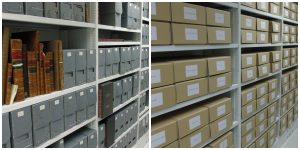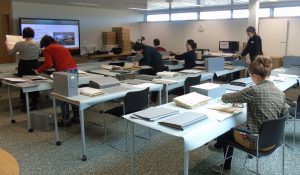Due to the success of last year’s ‘Crowdsourcing Conservation’ event, we are repeating the session on 19 and 20 February 2018! You can read more about last year’s event here.
This year, we will continue to work with the Laing collection, this time rehousing section IV. Over the two-day period we aim to rehouse 96 boxes, completing the boxing of the Laing manuscript material.

Boxes from the Laing II collections, before (left) and after (right) rehousing
Damage has been caused to these collections due to the current storage in vertical boxes. Folders have slumped in under-filled boxes, and caused planar distortion of the papers. Tearing and creasing has occurred due to the lack of internal protection. To solve this problem, we want to rehouse the collection in acid-free folders and boxes.
Each day will consist of a training session in the morning, followed by practical work. In the afternoon, students will be joined by staff members from the CRC who will talk to them about their roles, whilst helping to carry out the conservation work. Good quality complimentary refreshments and catering will be provided throughout the day to encourage networking during break times.

Crowdsourcing Conservation event at the CRC 2017
This is a great opportunity to get some hands on experience with special collections, and find out what it’s like to work at the CRC!
Places are limited to 15 participants per day. You can book your place through Eventbrite. If you have any questions, please email emily.hick@ed.ac.uk.
Booking will close on 8 February, to allow us to organise catering. Book now, don’t miss out!
Timetable
9.30 – 9.45: Welcome
9.45 – 10.00: Introduction to the Laing collection
10.00 – 10.30: Rehousing training
10.30 – 11.00: Rehousing begins
11.00 – 11.30: Tea break (refreshments provided)
11.30 – 13.00: Rehousing
13.00 – 14.00: Lunch break (lunch provided)
14.00 – 15.30: Rehousing and networking
15.30 – 16.00: Tea break (refreshments provided)
16.00 – 17.00: Rehousing and networking






